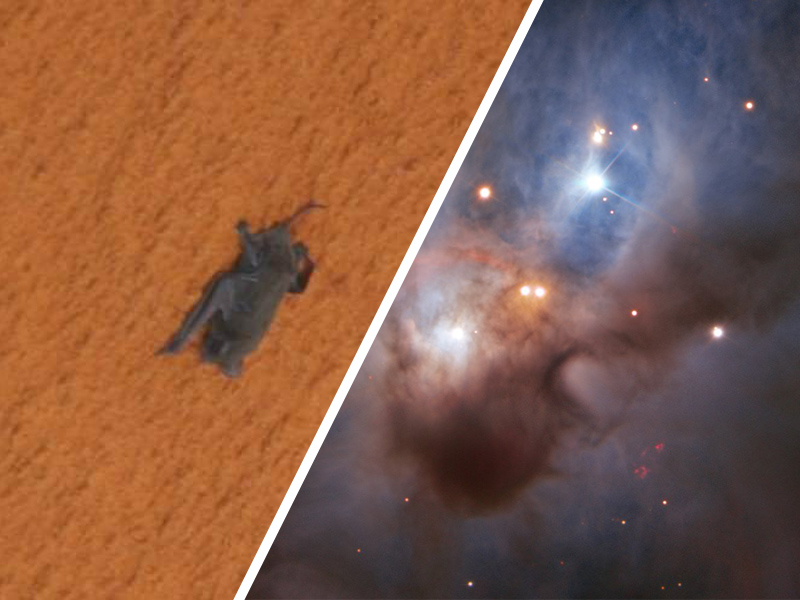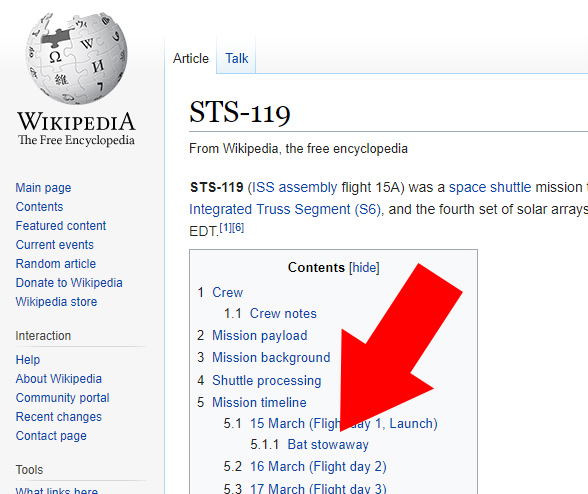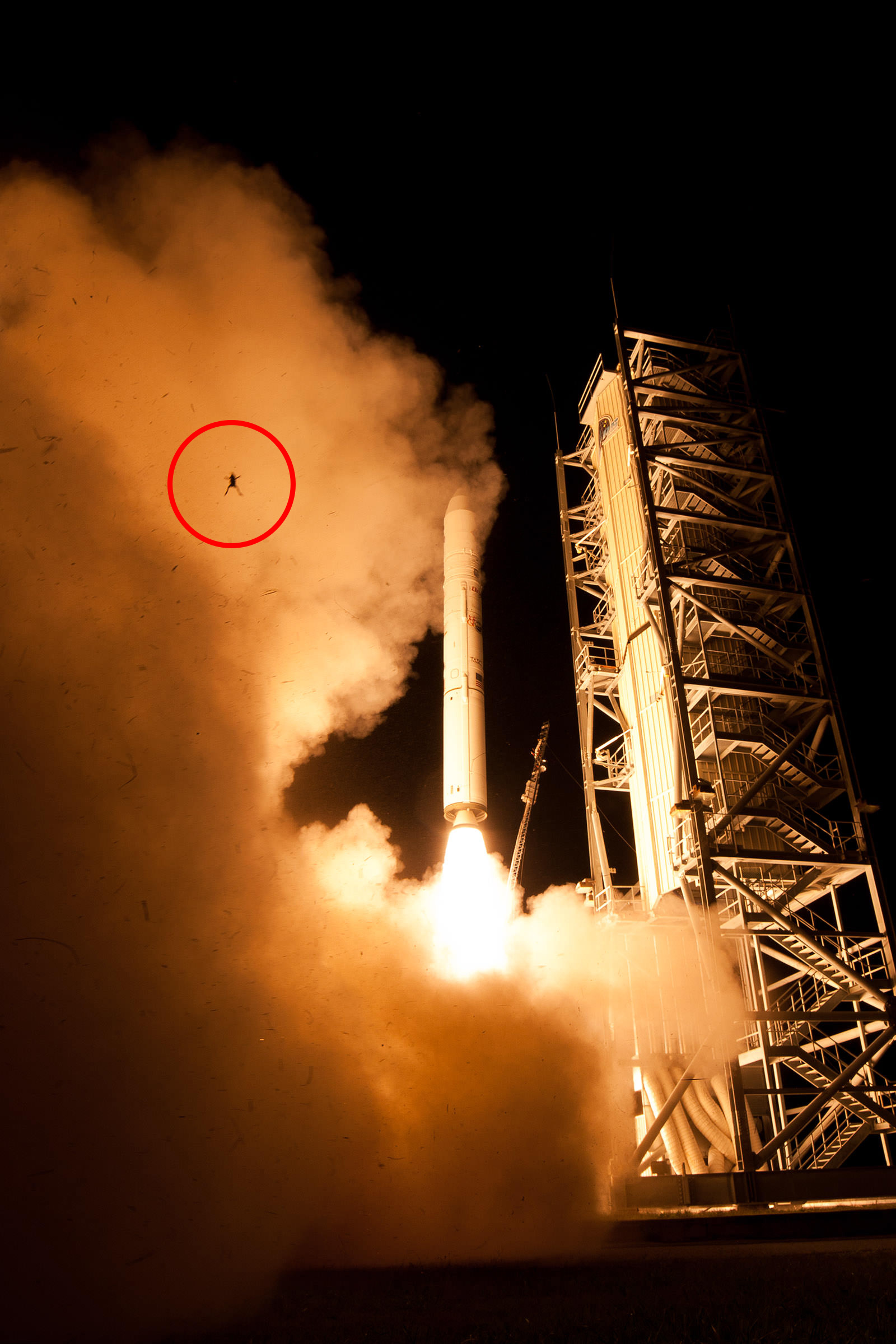Gather ’round the campfire kids, it’s time to tell the sad story of a brave bat named Brian.

On March 15, 2009, Twitter was days away from its third birthday, Ashton Kutcher was one month away from becoming the first tweep to reach one million followers, and a community of space enthusiasts habitually live-tweeted the final space shuttle launches from the comfort of their homes. They were simpler times.

One launch, however, became infamous — nay, historic — not for the fact it was one of the last handful of launches of NASA’s shuttle program, but because there was a tiny stowaway attached to the shuttle’s bulbous orange external fuel tank minutes before ignition.
That stowaway was an ill-fated bat named “Brian.” And “he” became a legend overnight.
A Legend Is Born
During the countdown to the launch of STS-119, as we watched in anticipation of the successful start of Space Shuttle Discovery’s International Space Station (ISS) servicing mission, something seemed amiss at Discovery’s launch pad. At the time, the assumption was that a fruit bat (a common species in Florida) had mistakenly thought the orange external fuel tank of the shuttle was a tree to latch itself onto. Follow-up investigations identified the bat as a free-tailed bat and, though its intentions were unclear, zoologists posited that the unfortunate critter may have broken its wing. This would explain why it didn’t fly away when the shuttle’s boosters ignited, carrying the bat to the heavens — literally and metaphorically.
No one really knows how long the bat held on for, but some creative-thinkers hypothesized that the bat remained attached for the duration, making it into space. I don’t think I have to explain why this didn’t happen — it was more likely booted from the fuel tank in the first seconds of launch enduring a fiery death via rocket booster exhaust — but it was a poetic thought. Regardless of the bat’s fate, it’s ultimate sacrifice made this routine launch special. What was “just another” live-tweeted shuttle launch, became a spectacle that rapidly evolved into an international news story. That bat was special.
And that bat’s name was Brian.
Why “Brian”? A bit of background: For some personal reason that I cannot fathom, I like to name things “Brian.” I’ve always done it. The squirrel that lives in my backyard? Brian. An interesting and unnamed rock on the surface of Mars? Brian. My first car? Brian. That gopher that demolished my newly-planted garden of impatiens in 2011? Brian. A random free-tailed bat hanging off the shuttle’s external fuel tank? Brian. There’s no reason and no logic behind this, Brian just seems to fit. It’s a personal mystery.
So, when lightheartedly tweeting about the bat on March 15, 2009, I called the bat Brian and the name stuck. I had no idea about its gender, and it didn’t have a nametag, but that bat was a Brian alright. Suddenly, other space enthusiasts following the launch called him Brian and, for reasons I have yet to understand ten years later, in those minutes before launch, “Brian the Bat” went viral and suddenly everyone was personally invested in that “routine” space launch. Yes, there were billions of dollars of hardware on that launchpad with seven brave astronauts on board, but everyone was talking about Brian who was shivering on the side of the vehicle, a place that no living creature should have been.
Was Brian confused? Was he frozen to the cold tank? Would he fly away in the nick of time? No one knew, but the clock was ticking and the commentator on the NASA live video stream seemed confident that, as the boosters began their ignition sequence, the bat would be scared by the vibrations and fly to safety.
For reasons known only to Brian, he remained attached. And as the boosters roared to life, he held tight. As the plume of smoke and steam enveloped Kennedy Space Center Launch Complex 39, I sat with the computer screen nearly pressed to my nose, seeking out the dark pixels of Brian in the place where he was last seen. But the resolution was too low and Brian’s fate was unknown. (Days later, NASA analysts reviewed infrared imagery from the launch, revealing two very sad facts. 1) Brian was warm while attached to the fuel tank, so he hadn’t frozen to death and was alive up to launch, and 2) he remained in place when Discovery lifted off.)
As the adrenaline ebbed and Space Shuttle Discovery soared into the atmosphere, solid rocket boosters separating and tumbling back to Earth, the sad reality crept in. Brian was, in all likelihood, toast.
But his legacy would live on.
Assuming that little space-launch chapter was over, I wrote a summary about Brian’s adventures for Universe Today and on Astroengine with the assumption that Brian would be soon lost to the annals of shuttle-era history. Little did I know, however, that Norwegian journalist Geir Barstein was paying close attention…

Then, a couple of days later, the new spread to the UK tabloid press…

Brian landed as a science headline in the Mail Online on March 19, 2009. Read the full article here. [Mail Online]
Brian also made appearances in The Sun newspaper (but the article has since disappeared) and other smaller publications, and I participated in a number of radio shows devoted to that now-famous shuttle launch.
Not only was the whole event a poignant one, it also made me realize something about the power of social media. In all my years covering space stories, particularly when I was a producer at Discovery News (now called “Seeker”), shuttle launches would receive very little attention. Apart from a few outliers, such as the final shuttle launch, the articles I’d publish about one of NASA’s most significant programs would receive very little readership. The routine nature of these launches meant that, unless you were at Cape Canaveral, interest in seeing shuttles launch into space was lukewarm at best. As a space enthusiast, I was frustrated. Every launch in my eyes was special and certainly not “routine.”
Brian, however, made me realize by accident that you have to seek out the unique thing about that one launch that will hook readers to that story. Granted, not all launches have a “Brian the Bat” moment, but that doesn’t mean they’re not special.
Remember the Lunar Atmosphere and Dust Environment Explorer (LADEE) launch? Thought not. But do you remember Frank the Frog? Probably:

Eerie Timing, ESO
Not only is it the TEN YEAR anniversary tomorrow (Friday) of when Brian met his maker, today the European Southern Observatory (ESO) released this stunning observation of the Bat Nebula, a reflection nebula that contains baby stars being birthed in a stellar nursery. Yes, I know, eerie, right?

I like to think that the cosmos is doing Brian a solid by commemorating that brave little bat’s ultimate sacrifice.
The event may have been a footnote in humanity’s quest to explore our universe, but I truly believe that the viral social media (and then mainstream media) attention Brian whipped up created a buzz around a launch that may not have otherwise made an impact.
As a science communicator, I’m always on the lookout for interesting hooks to stories that wouldn’t otherwise be of interest, and on March 15, 2009, Brian was that hook — who knows what kind of impact that little free-tailed bat had on viewers who wouldn’t have otherwise been paying attention to one of the biggest endeavors in human exploration history.
So, tomorrow, on March 15, 2019, raise a drink to Brian’s legacy. He will live on in the spirit he inspired when he left our planet attached to the space shuttle’s external fuel tank.

One thought on “Ten Years Later: The Cosmos Remembers Brian the Bat”